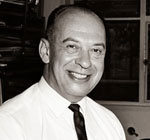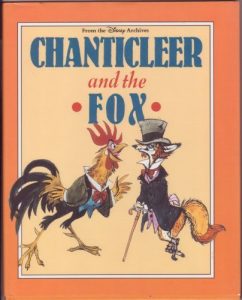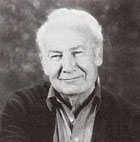 SUSPENDED ANIMATION #240
SUSPENDED ANIMATION #240
Marc Davis was called by Walt his “Renaissance Man” because of his contributions in so many areas from animation to Imagineering. He joined the Disney Studios in 1935 as an assistant to Grim Natwick on Snow White.
The last time I saw him was in September 1998 when he and his wife Alice came out to Walt Disney World for an official Disneyana convention.
They also dropped by the Disney Institute where I was working as an animation instructor. In one of the small classrooms, Marc squeezed behind one of the animation desks and turned to page twelve in the book I had given him to autograph.
 The book was Chanticleer and the Fox: A Chaucerian Tale published by Disney Press in 1991 and featuring concept art by Marc Davis for the unproduced animated feature.
The book was Chanticleer and the Fox: A Chaucerian Tale published by Disney Press in 1991 and featuring concept art by Marc Davis for the unproduced animated feature.
“You know what’s wrong with this picture?” he asked, and I froze because I was looking at the page that featured his character concept sketch of Reynard the fox and could only see the brilliant work.
Marc took a pen and sketched in a cigarette and a cigarette holder in the outstretched hand of the fox.
“They left that out. Politically incorrect, I guess,” he said and then autographed the book to me.
Surrounded by a half dozen other animation instructors from the Disney Institute, I began to informally ask Marc some questions. I previously shared an excerpt from the interview here at Cartoon Research.
Jim Korkis: I’d like to talk with you a little about some of the people you worked with in animation and unfortunately most people know very little about them.

Bill Peet
I was thinking about this a while ago when I did a little talk and was asked about Cinderella. An awful lot of people went together to make this whole thing. I got to thinking about them and I got sentimental over them. Some of these people who came and made a huge contribution to something that is there forever.
JK: Are there any memories you have of the animation storymen who worked at the Disney Studios?
MD: One of my personal favorites is a man named Bill Peet. He put together 101 Dalmatians. It was such an interesting film. It is a film that doesn’t have a bad scene in it or a scene that doesn’t belong in it. Animation wise there are some things I’d like to have another pass at but the story is solid.
 Walt had a great story crew. Ted Sears, Webb Smith, Bill Cottrell, Roy Williams. Roy Williams was primarily a gag man. Roy was the type of guy you would bring in to get some gags to punch up a scene. He was very volatile. You probably remember him from The Mickey Mouse Club television show.
Walt had a great story crew. Ted Sears, Webb Smith, Bill Cottrell, Roy Williams. Roy Williams was primarily a gag man. Roy was the type of guy you would bring in to get some gags to punch up a scene. He was very volatile. You probably remember him from The Mickey Mouse Club television show.
He had been quite a high school football star. He had a scholarship lined up for USC as a fullback. He came out during the summer. He liked doing funny drawings. He got hooked and couldn’t leave. Roy was an incredible character.
Here’s one of my favorite Roy Williams stories. He came home one day. His wife wasn’t there. So he goes to the mail box. Looks at the mail and here’s a thing from Forest Lawn cemeteries addressed to “Mr. and Mrs. Roy Williams”. He opens it up and it turns out his wife had purchased two crypts for them. Roy was appalled and practically shook the house apart. Then he got a sly feeling. He calls up Forest Lawn:
“Hello, my name is Roy Williams. I am a diabetic and they are going to amputate my right leg. When they amputate the leg, I want the leg put in that crypt because when I die completely I want to be all together.”
You can imagine the effect it had on them. He left them shaking for about a month. He never delivered the leg and they kind of breathed a sigh of relief I guess.
I must have a stack of Roy Williams’ drawings that must be this thick. (indicates several inches high with his thumb and forefinger) He always drew me with long eyes that came out so far you could knit socks and all kinds of things. Any of us who worked with Roy could tell Roy Williams stories for three to four hours each and never repeat a story.
 JK: What about T. Hee?
JK: What about T. Hee?
MD: T. Hee was a great caricaturist. I asked him, “Why are you here at Disney? Why aren’t you out doing caricatures for Vanity Fair and such?” He said the truth is, and this is something Walt knew as well, that there is no money in satire. To satirize somebody is a very difficult kind of entertainment to do because you make enemies. Walt did not care for that. Walt saw and liked something being real and this is what caricaturists didn’t do.
I never saw anybody who could sit down and come up with a likeness of an individual so quickly. But they are not easy things to sell.
 JK: Any other storymen stick out in your memory today?
JK: Any other storymen stick out in your memory today?
MD: Larry Clemmons was a marvelous storyman. There was a group that went up to Walt’s office after work and Walt was pouring a glass of Scotch for everybody. Larry Landsburgh was there as well and he had been someplace and had bought a watch. It was waterproof.
Somebody said, “They can’t make a watch that is waterproof.” So Landsburgh pulled the watch off his wrist and dropped it in his drink. Walt heard all this commotion and came over and looked at the watch in the glass and said, “Whose watch is that?”
Somebody said, “That’s Larry’s.” Walt thought it was Larry Clemmons and poor Larry got a hard time after that from Walt and finally left the Studio for a few years. He wrote for Bing Crosby for quite a number of years very successfully. He came back to the Studio again and everything was fine. I guess the moral to the story was don’t stand next to someone who has the same first name as yours.
 JK: I know you and your wife were good friends with Mary Blair.
JK: I know you and your wife were good friends with Mary Blair.
MD: Mary Blair whose work you probably see best in the two South American films that were done. She did a tremendous job of design. She was such a magnificent designer and colorist. She personally, and very few people ever did this, effected Walt and his judgment and his taste. With her work, she changed Walt’s taste and brought an awareness that there was some other kind of art than things that just looked like things.
Mary I don’t think we ever understood until probably she had long left what her real contribution was. She tended to be a rather flat designer. How the rest of us would interpret what she did was a very critical thing. We were always going through a learning process together.


 Jim Korkis is an internationally respected animation historian who in recent years has devoted his attention to the many worlds of Disney. He was a columnist for a variety of animation magazines. With his former writing partner, John Cawley, he authored several animation related books including The Encyclopedia of Cartoon Superstars, How to Create Animation, Cartoon Confidential and Get Animated’s Animation Art Buyer’s Guide. He taught animation classes at the Disney Institute in Florida as well as instructing classes on acting and animation history for Disney Feature Animation: Florida.
Jim Korkis is an internationally respected animation historian who in recent years has devoted his attention to the many worlds of Disney. He was a columnist for a variety of animation magazines. With his former writing partner, John Cawley, he authored several animation related books including The Encyclopedia of Cartoon Superstars, How to Create Animation, Cartoon Confidential and Get Animated’s Animation Art Buyer’s Guide. He taught animation classes at the Disney Institute in Florida as well as instructing classes on acting and animation history for Disney Feature Animation: Florida.




















































The treatment of Marc Davis in his later years at Disney, based on information from the recent book ” Marc Davis In His Own Words” is sad –
although at times there can be two sides to every story.
PS: there is no D in Larry Lansburgh.
His name is burnt into me through the countless times it appeared at the beginning of “The Wonderful World Of Disney” .
On a completely different topic, some may be unaware that for the print of Lady And The Tramp (1955) on Disney+ , Si And Am will undergo some redubbing.
Where’s the source of this? I find that rather stupid as no one has complained about it (except for Watch Mojo and other Internet idiots that can’t keep their interfaces shut).
That is a shame they’re bothering to screw around with that film.
Forgive me, I know this post is about Marc Davis and the Disney story people, but I want to clarify this business about the Siamese cats before it goes any further.
I think Nic Kramer’s scepticism is warranted. After an hour or so of googling, I leaned that the Siamese cat song has been rewritten for the new live-action remake of “Lady and the Tramp” that is premiering on Disney+ this month. I also learned that Disney has redubbed some lines in two episodes of “Gravity Falls” because the actor who originally recorded them has confessed to a history of sexual misconduct. But as for any changes in the original 1955 “L&tT”, I could find no evidence whatsoever. In fact, according to snopes.com, rumours of the song being cut for home video release have been floating around since as far back as 2001, but there’s no truth to them. So the whole thing appears to be one big game of Chinese Whispers, if you’ll pardon the expression.
For what it’s worth, I bought the 1955 “Lady and the Tramp” DVD just a few weeks ago, and the Siamese cat scene with its original soundtrack was entirely in situ. Nor was there the usual disclaimer that “this film reflects the cultural attitudes of its time.” But then, I live in a country where “Song of the South” was released on VHS without incident, so….
This is a great article. Animators’ stories make me wish that another series similar to “THE DUCK FACTORY” would be created, perhaps on one of the cable stations because we all know what the majors would micro-manage such a nitch idea to be. People see the contrived version of the Disney creative process and believe that it is all smiles all the time. They don’t really know what goes into making a cartoon. Reading these commentaries allows us all to know how each contribution goes to creating the puzzle pieces of the whole. It must, therefore, hurt those who contribute to these films to see their work altered for whatever reason over time.
I always was amazed that T.Hee’s real name was T.Hee.
Off-topic, but noting the Mary Blair photo, has there been any talk of restoring her old PeopleMover mural one way or another?
I got to attend a guest lecture by Marc Davis when he spoke at the University of Washington in the late 70’s/early 80’s. He went into some detail about his career and the animation process. He also showed two test reels–one for “Dragonslayer” and one for the live-action “Popeye” film. The “Dragonslayer” reel was quite different from the way the film appeared in its theatrical release. Mr. Davis also made the announcement that one of Disney’s stars was making a comeback soon. This was the first announcement I encountered of “Mickey’s Christmas Carol” which was in development at the time. Mr. Davis referred to it as a feature, however, not as a short. I have often wondered since if the film was originally intended to be a full-length feature and then later pared down during production to its shorter running time. In any case, it was an eventful evening and Marc Davis had plenty of worthwhile remarks.
When I talked with Burny Mattinson many years ago, he told me that Mickey’s Christmas Carol was always intended as a featurette (and even considered making it an annual Christmas special on CBS like other popular half hour Christmas shows) but that the work went so well that there were discussions about expanding it into a feature (Burny’s long time dream was an animated feature with the Fab Five).
Burny offered suggestions for expansion including having Scrooge pass a pet store every day on the way to work with an eager Pluto in the window trying to get his attention. Scrooge was immune to the dog’s charms but at the end would eventually bring him home as a gift to Tiny Tim.
Ron Miller was interested in the idea of a feature but was talked out of it by other executives who felt that the film would only be able to be shown during the holiday season so would not generate enough income on re-issues.
Burny told me, “It came awfully close!”